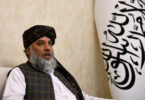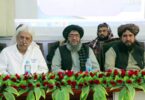KABUL (Agencies): The quick collapse of the Afghan National Army stunned many, including the Pentagon’s top military officer, Gen. Mark Milley. He told reporters this week that the US intelligence community estimated that if US forces withdrew, it would be weeks, months, even years before the Afghan military fell to the Taliban. Instead, it was just 11 days. So what happened? How could US officials be so wrong?
The answers lie in the chronic challenges that plagued the Afghan military from the outset, from illiteracy to corruption to incompetence to one of the key problems: a lack of faith in the Kabul government. Carter Malkasian, a longtime Afghanistan observer and author of The American War in Afghanistan, seized on that last point in explaining the fall of the country to the Taliban. The Taliban fought with an ideological fervor and to rid the country of the foreign invaders, values enshrined in Afghan identity.
“It animated the Taliban. It sapped the will of Afghan soldiers and police. When they clashed, Taliban were more willing to kill and be killed than soldiers and police, at least a good number of them,” he said. We have both embedded many times with US and Afghan forces. Some of what we witnessed, as well as the conversations we had, may help explain the challenges the Afghan army faced.
In 2016, we visited the Kandahar military training center. There we met 23-year-old 1st Lt. Hayatullah Frotan. He was just 14 when he joined the army, and he quickly rose through the ranks. Even back then, he told us the government wouldn’t help the families of slain soldiers. “They don’t have any policy, any good plan,” Frotan told us, “when they lose some personnel.”
If the government provided for the families with death benefits, he said, “the personnel morale will become high. And they will fight like lions.” Then there was lack of leadership. The Afghan National Army struggled to find qualified commanders to lead the soldiers. Over the years, we met Afghan generals praised by the US military, only to find out later the generals were replaced for incompetence or corruption. Some generals pocketed pay meant for soldiers. Others were supposed to buy the best rice for their troops. Instead they bought the cheapest and lowest quality possible and pocketed the difference. Still others sold government-issued firewood meant to keep the troops warm.
Frotan said the system was marked by cronyism, with not enough loyalty to the troops. The leaders were not only corrupt. Some of them were illiterate. “They don’t know how to write. They don’t know how to read,” Frotan said. “How to be professional soldiers and leadership is very, very important.” The lack of education led to basic problems with tasks such as maintaining equipment, from rifles to vehicles, to ordering spare parts.
And not knowing how to write meant these leaders couldn’t even read the maps properly. NPR was with an Afghan army unit six years ago when it was shooting artillery rounds at the Taliban. It was off by a kilometer because it couldn’t figure out the proper grid coordinates. Not only that, but Frotan says commanders often had trouble filing simple paperwork to give soldiers time off. “They don’t have enough knowledge, so they cannot make a good schedule for their vacation,” Frotan said. So with no proper time off, that meant burnout among the troops, which led to high attrition rates.
Years ago, a US general told us that not only couldn’t many of the Afghan officers read or write, but they couldn’t count. He said the Americans at times would draw a large rectangle in the dirt, telling the officers they needed enough soldiers to fill that space. Nearly 60,000 soldiers and police officers have lost their lives fighting since 2001, the majority just in the past six years, according to a report from the Brookings Institution.
The high death rate meant a constant flow of new recruits who needed basic training. Few could advance enough to learn the more complex skills. US military trainers like Maj. Kevin McCormick told us that teaching advanced military skills is a time-consuming process. “It takes a lot of time. It is not a short process,” McCormick said. “These skills are perishable. They require continuous training, continuous mastery.”
In our conversations with Afghan soldiers, we also heard other complaints. Commanders deprived troops of SIM cards, so they couldn’t call their families. Many soldiers either ended up deserting or not reenlisting. Over the years, there were more basic challenges. In 2010, NPR was at a combat outpost before dawn with US and Afghan troops. The Americans were all geared up, ready to go on patrol. Some of the Afghan forces were half-dressed, smelling of hashish and asking for food.
Two years later, NPR was with another US unit. A sergeant was telling his soldiers what he expected of the Afghan soldiers — the Afghan National Army. “ANA is going to lead too. If they don’t want to lead, just stop and make them walk ahead of you,” he told his soldiers. The Afghans could do little without US support. The US soldiers in the field knew the truth. But during this time, from the Defense Department to the White House to Congress, officials had the same thing to say: The Afghan army is getting better every day. They are fighting hard. They are leading.
Many of these problems were outlined in numerous reports by John Sopko, the special inspector general for Afghanistan reconstruction. But these reports never seemed to resonate with members of Congress or prompt oversight hearings, like the Fulbright hearings during the Vietnam War. When the Taliban started their advancement this year, the Afghan National Army, held together by duct tape and glue, just couldn’t hold. Support from US airstrikes against Taliban units dropped off. One soldier told us that the Taliban also gave payments to Afghan soldiers who refused to fight, providing the most money to the officers.
Even high-ranking Afghan military leaders gave up. In an NPR interview, an Afghan Air Force colonel who is now hiding in Kabul said that it was impossible to lead in such dire conditions and that this in turn affected the troops. “The willingness comes from the leadership,” he said. “The hope is given to the subordinates from the leadership.”
So when the military leaders give up, the unit quickly falls apart — a common occurrence among Afghan army units. But there was another very powerful fighting force: the Afghan commandos. They were highly trained soldiers, some 22,000 of them among the 300,000 Afghan troops, and they were the backbone of Afghanistan’s fighting power. Over the years, they were stretched thin, flying all over the country to back up regular Afghan army units that couldn’t or wouldn’t fight. They often complained about this to NPR reporters. One told us they were meant for special missions, not to handle basic operations that were supposed to be the job of rank-and-file soldiers.






